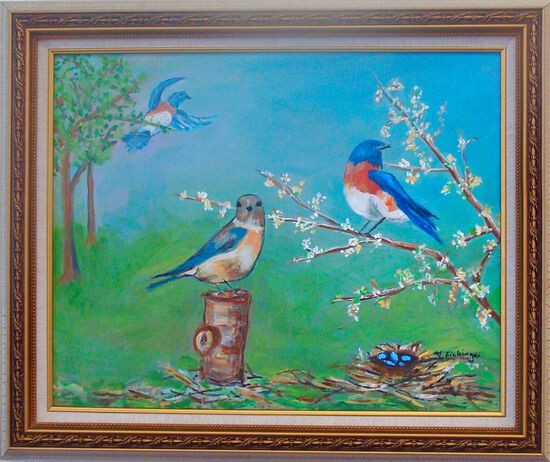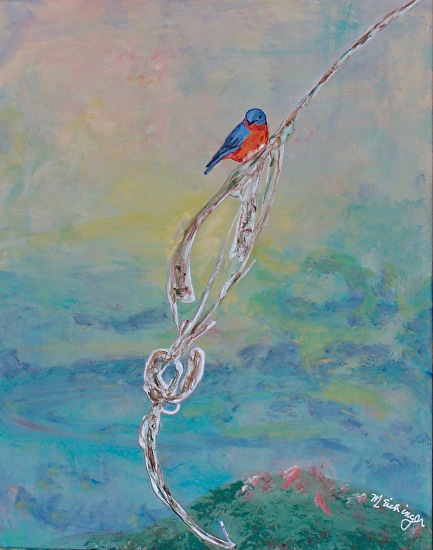
Bluebirds Communicating 
Personal Space
Blue Birds Personal Space
Emerging from COVID with Friends
Anais Nin wrote, “Each friend represents a world in us, a world possibly not born until they arrive, and it is only by this meeting that a new world is born.” She implies that joy, companionship, and growth come from friends influencing how we experience the world. A colleague once advised me that it takes twenty years to make a friend. The comment seemed extreme, but as I’ve aged, I’ve given it more credence. Strong friendships are a critical part of our well-being, but they take nurturing and time to develop.
Zack, the twenty-year-old homeless boy I write about in Over the Peanut Fence, made street-friends instantly. After spending a few hours with a new arrival, he would call the youth a friend, an indication that he was open to knowing the person better. Over the following weeks, the relationship was tested by observing the youth’s willingness to share his limited resources. If he had cigarettes, he was expected to offer some to his friends. If she pulled in ten dollars begging, she bought the \pizza and gave her friends a slice. When the person was known as someone willing to share, he or she was valued and could expect to receive favors and help in return.
Loyalty grows quickly in an environment where individuals share experiences and hardships. Simply sharing the brutal story that led the youth to flee home creates bonds. Hearing these tales makes homeless youths realize they are not the only ones to have suffered. They help them take small steps forward towards trusting people again. If caught stealing, the street-thief will take all of the blame, never tattling on a friend involved in the hoist. If a gay or lesbian youth is bullied, friends join together to fight against the perceived injustice. Though street relationships develop quickly, they are lost equally as fast. Those who choose not to partake in drugs or decide to return to school, for instance, have accepted a lifestyle that no longer supports the habits of their former acquaintances. Rather than lose their friends’ trust, they disappear.
Children tend to make friends easily. School, camp, clubs, and sports teams where time is spent with people their age, spurs fast friendships. Adults, unfortunately, find it more difficult to create enduring relationships. They don’t happen automatically as they did when in school unless put in situations where they have to depend on one another, as in the military. For adult intimacy to deepen, it requires intention, time, and effort. Though progress may be slower, growing acquaintances is a similar process to the one homeless youth experience. It involves giving something of yourself before you can expect something in return.
Strong friendships are built on a foundation of sharing, honesty, and trust. Rock climbers and combat soldiers have to trust one another for their lives depend on it. That is not the case in most situations, but it is in some. If a person becomes ill, divorced, traumatized, or elderly their survival often depends on the willingness of a friend to help out.
Research presented in Psychology Today shows that friendships have mental and physical benefits that contribute to self-esteem, greater happiness, a sense of purpose, lower blood pressure, and a longer life span. A University of North Carolina study concluded that having numerous friendships is most beneficial during adolescence and old age. Middle-aged people are less affected by the number of friends they are connected to but more concerned by whether the relationships they do maintain provide support or add strain. My relationships over time fit into their pattern.
As a child, a college student, and a young adult I had lots of friends and enjoyed doing things with them. When I became a young parent, my husband and I expanded our friendship circle to include couples raising young children. However, by middle age, when deeply involved in the work and care of older children, I spent less time nurturing these relationships. The dinner parties and events I gave and attended were often related to my work. The people I called friends were likely to be colleagues, board members, and professional contacts. It is customary to leave work-friendships behind to let the new president bond with the staff and board when you exit a position as president of an organization. No one wants to run an organization with a shadow over their shoulders saying the old way was better than the new.
Friendless when I left OMS, I started the Museum Tour Catalog, imagining things would be different when the business sold and I retired. That was not the case. The purchaser asked the staff not to socialize with me. Building close relationships anew could only be accomplished with intention. I took pottery classes, stayed to socialize after exercising at my club, became a lay minister, and talked to neighbors strolling by the house. I arranged for walks and luncheons with friends I hadn’t seen for years. It was an effort and took time to deepen these relationships, but it felt worthwhile. I slowly developed a circle of friends I could call on when needed and committed myself to do the same for them. When COVID-19 burst on the scene, however, it inhibited my traditional ways of interacting.
Studies show that during the pandemic younger more than older adults reported their friendships had suffered. Though elderly individuals expressed loneliness, younger adults and those less educated were hit harder. Men’s friendships suffered more than women’s because of the way they tend to interact with friends. In general, men enjoy doing things together like watching or playing sports. When together, they stick to concrete subjects while women communicate emotions more directly when conversing. These are stereotypes for sure, but Psychologist, Dr. Denworth claims they are based on cultural and biological truths.
This last year, people came to view friends as a source of risk rather than as a way to manage it. Instead of going to a friend’s house to ask for help or get advice during the crisis, we spoke through masks and computer screens. We couldn’t hug or comfort friends who were ill or lost a loved one or do the many little things that demonstrate to your friend that he or she is valued. Young people, especially, felt guilty for putting friends and family members at risk. Elders found it easier to slip into loneliness than find ways to make new friends.
There are exceptions, of course, for those who had close relationships and who were determined to nurture them through the pandemic. When they had a serious need, neighbors stepped up by leaving food on doorsteps, shopping for friends unable to do so, and calling to see how they were faring. Close friends and relatives stayed connected as best they could through Zoom. They joined book clubs, writing groups, and gaming associations. Unfortunately, we have a society that values individualism, and many find it difficult to ask for help though most people willingly do so. It is the back-and-forth give-and-take that builds bonds.
As we heal from a year of isolation, it will take effort to rebuild our relationships. For some, it will be as difficult to resume face-to-face interactions as it was to pull back from them during the pandemic. We are creatures of habit and find it hard to change. In the long run, however, it will be worth bursting the bubble we were forced to be in. Re-establishing friendships requires us to emerge from our cocoons and let people know how we evolved over the past year so we can fly with gusto into the future.
References:
Franco, M. (2019) 5 Skills for Making Friends as an Adult. Psychology Today. retrieved from https://www.psychologytoday.com/us/blog/platonic-love/201909/5-skills-making-friends-adult
Denworth, L. (2021) How Friendship Has Changed in the Pandemic. Psychology Today. retrieved from https://www.psychologytoday.com/us/blog/brain-waves/202102/how-friendship-has-changed-in-the-pandemic
Art is always for sale. Contact me for information at marilynne@eichingerfineart.com.
Western Bluebirds / acrylic on canvas / 20.5 x 24.5/ framed / $375
Personal Space / acrylic on deep canvas /16” by 20” / $299